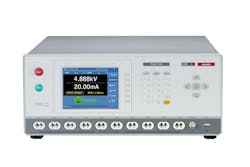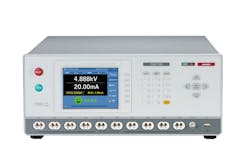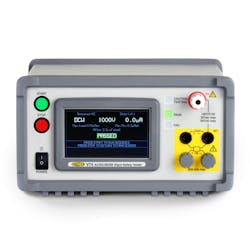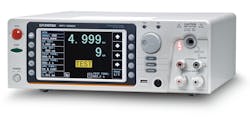Special Report: EST instruments provide safe environment to ensure compliance
Download this article in .PDF format.
Designers and manufacturers of electrical products—from consumer appliances to medical equipment—need to ensure that their customers can use the equipment safely and that the products will comply with relevant industry standards. Consequently, the designers and manufacturers will rely on instruments such as hipot testers, ground-bond testers, leakage-current testers, and insulation-resistance testers to ensure their products’ quality and safety. In this report, participants in the electrical safety testing (EST) industry comment on their product offerings, applications areas, challenges, and trends.
Challenges
Chad Clark, VP of sales at Vitrek, said a key challenge is assuring a safe test environment. Yet another challenge is making sure to perform all tests required to comply with applicable safety standards. “This is particularly important when the product is sold/used in multiple global markets with differing standards requirements,” he added.
Nick Piotrowski, Ikonix USA product manager, identified functionality vs. price point as a key challenge. “EST is driven by standards-based testing (IEC, UL standards, etc.). As a result, it covers a wide variety of products, and not everyone’s requirements are the same,” he said. “Additionally, standards groups (technical committees that create the standards) don’t always collaborate between industries.” For instance, TC66 (Technical Committee for the IEC 61010-1 standard family–Laboratory Equipment) might not collaborate on standards writing with TC108 (IT & Video/Audio Equipment). “This creates discrepancies between different standards even though there is a great deal of crossover between these industries and safely testing similar products,” he said. “As a result, the manufacturer or vendor is forced to offer a product that covers full-spectrum EST. This is more expensive to manufacture and thus becomes more expensive for the customer.”
Piotrowski also cited resistance to upgrading/change, noting that industrial EST equipment innovations tend to lag consumer electronics, for several valid reasons. First, “New equipment is expensive,” he said. “A customer might not have the budget to upgrade EST equipment every few years, yet the rate of change of technology is moving at a quicker pace than ever.”
Second, Piotrowski cited qualification. “In many industries (for example, medical) changing equipment in a testing/manufacturing process requires a complete revalidation of the system,” he said. “This is a time-consuming and expensive process. As a result, customers try to hold onto their equipment if possible, to avoid these changes.”
Finally, Piotrowski cited geopolitical barriers. “Not every country (and thus market) has the same set of requirements on technology,” he said. “Sometimes there are separate and/or additional requirements. It falls on the manufacturer to contend with complex international requirements if they want to compete in a global market. This is time consuming and expensive.”
Carter cited as an example of the expanded product range the new 11210 battery-cell insulation tester. “On rare occasions, an electrical short can develop inside the cell after passing production tests due to burrs or particles on the positive electrode reaching the negative electrode after inflation occurs,” he explained. “If these cells that are susceptible to failure pass through to the end user, the results could be catastrophic. The 11210 provides a solution for manufacturers to mitigate these occurrences in the dry-cell stage.” The company offers a white paper on the subject.1
Gregory Smith, U.S. director of sales at Instek America Corp., cited lack of knowledge regarding the various compliance standards and test parameters as a key challenge—as well as a lack of understanding of the engineering concepts behind the tests, especially in some unique application areas. The company can provide large companies with individualized product training, he said.
Products
Carter at Chroma described the company as a one-stop source for electrical safety test products, offering instruments from basic, standalone hipot and ground-bond testers to impulse winding testers, LCR meters, and more in addition to the battery-cell insulation testers. “At the forefront of our offerings are fully automated test systems that can incorporate safety tests with many other electrical tests that are often required by OEMs,” he said. “Our instruments are built for automation, and we are experts in integrating them into turnkey solutions for a wide variety of test requirements.”
Specific products in addition to the 11210 include the 19036 hipot, IR, DCR, and impulse-winding test combination unit for the EV space and the recently introduced 19311-10 for the lead-acid battery industry. “We love tackling new applications and learning more about budding requirements in new and growing industries,” he said.
Carter said Chroma offers a range of accessories and soft panels to help set up a complete solution; its CaptivATE automation software supports automated hipot, leakage-current, and functional tests. “For medical device manufacturers, CaptivATE supports IEC60601-1 test requirements and provides IQOQ protocol documentation,” he added.
Ikonix offers EST products from its Associated Research (AR), SCI, and Associated Power Technologies (APT) divisions. “Both the entire AR and SCI product offerings are designed and manufactured for electrical safety testing,” said Piotrowski. “The APT AC power sources are commonly used to provide power for functional and leakage current tests.” Specific products include the Associated Research HypotULTRA Series electrical safety compliance analyzer, the SCI Model 294 DC hipot tester, and the Associated Power Technologies 300XAC Series programmable AC power source.
According to Pederson, “B&K Precision’s soon to be released 3600 Series programmable hipot testers combine functionality and safety in a cost-effective solution. This series features AC, DC, and insulation resistance tests along with open/short detection, which saves time by ensuring the DUT is connected properly and eliminates false positives. The GFI and shutdown interlock features ensure a high level of operator safety.” Pederson added, “The 3600 Series features programmable ramp up and ramp down as well as dwell time for greater control over the testing process and the ability to support many regional standards.”
GW Instek offers a variety of safety test products, including hipot testers such as the GPT-9800 electrical safety tester with 200-VA AC test capacity; the GCT-9040 40-A AC ground bond tester, which measures resistance from 1 mΩ to about 650 mΩ; the GLC-9000 leakage-current tester; and multiplex scanner boxes for safety testers.
“Our GPT-12000 electrical safety tester includes the ability to perform intuitive interactive control, and also remote/automated operation via LabVIEW software drivers,” said Smith. The GPT-12000 Series can also save test results to a text file on a USB drive, and statistics and analysis results on instrument screen shows the quality of the batch without the need for an external PC. A barcode function facilitates scanning of barcodes, for manual and automated tests on an assembly line.
Applications
When asked what applications—such as medical equipment, consumer appliances, lighting, industrial equipment, or communications equipment—his company serves, Smith at Instek America said, “All of the above—anything and everything that plugs into the wall.” He added that the company supports powered component and powered subassembly test.
Vitrek, too, supports a similar broad line of applications, with Clark singling out cable testing. The Kikusui spokesperson cited automotive, battery, consumer-appliance, medical, component, and industrial-power-supply applications coupled with system integration.
Carter said Chroma serves applications areas extending from basic lighting to complex medical test. “We serve small-level component testing to large motor testing and most things in between,” he added.
Piotrowski at Ikonix said the company’s products span the full spectrum of safety testing, catering to a variety of industries, including appliances (consumer and industrial), electrical medical devices, lighting and LEDs, laboratory equipment, consumer electronics, machinery, lead-acid and Li-ion batteries, EVs, components (transformers, capacitors, and electrical switching equipment), and solar and wind energy.
Operator safety
To ensure operator safety, an interlock function is standard on all Kikusui electrical safety testers to ensure that the test fixture is secured, said the company’s spokesperson, adding, “We also have double-hand operation remote control to offer safer test operation.”
Clark at Vitrek cited a number of high-level operator safety features, including a GFI high-speed shut down for earth-ground leakage faults; the company’s SFI Safety Fault Interlock, which provides high-speed shut down on interruption of a tester’s safety interlock; and Vitrek’s TLSS Test Lead Safety Sense, which clamps DUT chassis near ground by continuously verifying proper connection of test leads prior to and during high-voltage testing. The company also offers power receptacle test adaptors, IEC 320 C13 power socket hipot lead sets and ground bond test lead kits, and a retractable tip test pistol lead set.
Other safety features include a built-in equipment interlock with both software controlled I/O port and connection to hardware disabling output, Piotrowski said. A SmartGFI feature monitors leakage to ground to ensure no shock hazard posed to operator; if leakage exceeds set value (0.1 to 5 mA), the instrument output is disabled.
According to Carter at Chroma, “All of our electrical safety products feature a safety interlock, and most of our products where applicable have a ground-fault-interrupt circuit which will cut off the output if the unit senses a current imbalance.”
Pederson at B&K Precision commented, “Operator safety is one of our top concerns. Our new 3600 series supports this with an interlock connection which will instantly stop the testing process when engaged. Any normally open switch connected to a door or gate, hand safety switch, or other safety device will activate the interlock. Ground-fault detection is also available to stop the test if a short to ground is detected.”
“Our newer GPT-12000 Series meets IEC 61010-2-034 design requirements, such as double insulation for input and output voltage, safe output/warning mechanism, post-test discharge mechanism, as well as a safety interlock feature to prevent execution of a test without first closing a specific circuit to ensure user safety during the operation,” Smith said.
Trends
According to Pederson at B&K Precision, safety standards have evolved along with the testing methods and equipment used. “Traditionally, a simple DC-only hipot tester was all that was needed,” he said. “These testers typically employ a low current useful for testing capacitive DUTs. In more recent years, AC hipot testers have increased in popularity, bringing with them several advantages: The AC test signal stresses the insulation in both polarities, discharging the DUT is not necessary, and no voltage ramping is required, to name a few.”
Carter at Chroma put automation, traceability, reliability, and test repeatability at the forefront of electrical product safety testing. “We see a strong trend that more customers want a test solution that can check all of these boxes,” he said. “A major part of our business is providing automated test systems, and we pride ourselves in our ability to deliver both off-the-shelf and/or custom solutions for our customer’s exact needs.”
Piotrowski at Ikonix also cited automation as a trend, along with data and control, resulting from the move toward IoT and integration with all forms of production and manufacturing processes. “This trend includes analytics to determine trends in passes/failures and measurements of electrical safety testing equipment integrated into the overall manufacturing line for a complete picture of the production process,” he said. “For example, a user could implement integrated software to talk to multiple pieces of equipment (EST and otherwise), upload all tests and data to the system (or cloud), and analyze overall efficiencies in production.”
Smith at Instek America Corp. cited several trends in product safety test. “Instruments must always have relevant protection and safety warnings for the test operator during test execution,” he said. He also cited an increasing need for both manual/interactive operation and remote operation/automated testing as well as an increasing focus on test data collection and storage and automated statistical analysis supplied by the test equipment. “Customers don’t expect to pay additional fees for software to do all of the above,” he concluded.
REFERENCES
1. Grodt, Steve, Decreasing Risk of Electrical Shorts in Lithium Ion Battery Cells, White Paper, Chroma Systems Solutions, 2020.
2. Clark, Kevin, Fundamentals of Electrical Safety Testing, White Paper, Vitrek LLC, November 2018.
Companies mentioned






